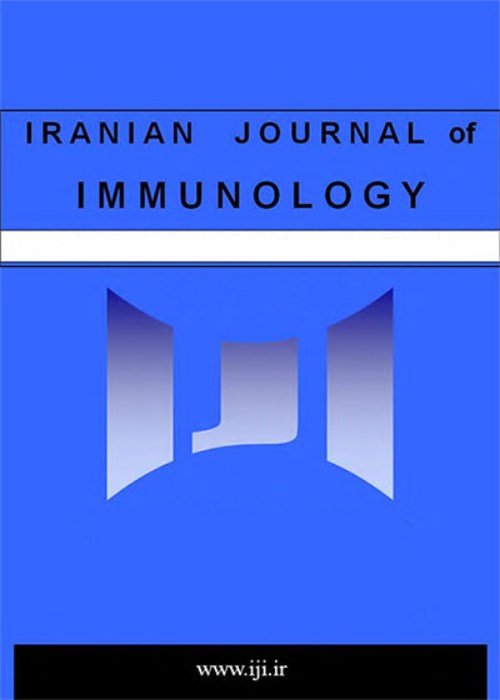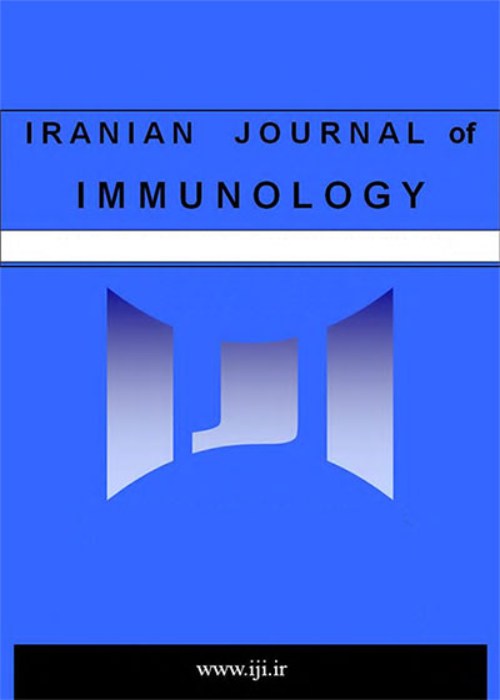فهرست مطالب

Iranian journal of immunology
Volume:20 Issue: 4, Autumn 2023
- تاریخ انتشار: 1402/09/10
- تعداد عناوین: 9
-
-
Pages 382-399
Cell-mediated immunity (CMI) is crucial in controlling the highly aggressive and progressive SARS-CoV-2 infection. Despite extensive researches on severe COVID-19 infection, the etiology and/or mechanisms of lymphopenia, decreased T cell-mediated responses in patients, cytokine release storms (CRS), and enhanced pro-inflammatory mediators are not fully understood. Several T cell subpopulations, including innate-like lymphocytes (ILLs) and conventional T cells, are involved in COVID-19 infection; however, their contribution to immunity and complications remains to be more elucidated. CD16+ T cells are among the effective players in the development of T helper1 (Th1) responses in COVID-19 infection, while their robust cytolytic properties contribute to lung tissue damage. While CD56-CD16bright NK cells play a protective role, natural killer T (NKT) cells, mucosal-associated invariant T (MAIT) cells, and γδ T cells and their roles in COVID-19 require further investigation. The involvement of the other T cell subsets, such as Th17, along with neutrophils, adds to the complexity of the situation. In this review, we presented and discussed the findings of recent studies on T cell responses and the contribution of each type of immune cells to COVID-19.
Keywords: Cell-mediated Immunity, COVID-19, γδ T cells, Mucosal-Associated Invariant T cells, NKT Cells, T helper cells -
Pages 400-409Background
Few studies have evaluated COVID-19 vaccine efficacy in patients with inborn errors of immunity (IEI).
ObjectiveTo evaluate the levels of antibody (Ab) production and function after COVID-19 vaccination in IEI patients with phagocytic, complement, and Ab deficiencies and their comparison with healthy controls.
MethodsSerum samples were collected from 41 patients and 32 healthy controls at least one month after the second dose of vaccination, while clinical evaluations continued until the end of the third dose. Levels of specific anti-receptor-binding domain (RBD) IgG and anti-RBD neutralizing antibodies were measured using EUROIMMUN and ChemoBind kits, respectively. Conventional SARS-CoV-2 neutralization test (cVNT) was also performed. Cutoff values of ≤20, 20-80, and ≥80 (for cVNT and Chemobined) and 0.8-4.2, 4.2-8.5, and ≥8.5 (for EUROIMMUN) were defined as negative/weak, positive/moderate, and positive/significant, respectively.
ResultsA considerable distinction was observed between the Ab-deficient patients and the controls for Ab concentration (EUROIMMUN, p<0.01) and neutralization (ChemoBind, p<0.001). However, there was no significant difference compared with the other patient groups. A near-zero cVNT in Ab-deficient patients was found compared to the controls (p<0.01). A significant correlation between the two kits was found using the whole data (R2=0.82, p<0.0001).
ConclusionDespite varying degrees of Ab production, all Ab deficient patients, as well as almost half of those with complement and phagocytic defects, did not effectively neutralize the virus (cVNT). In light of the decreased production and efficiency of the vaccine, a revised immunization plan may be needed in IEI.
Keywords: COVID-19 vaccines, Immunologic deficiency syndromes, Neutralization tests, Viral antibodies -
Pages 410-426BackgroundCD38 is highly expressed on multiple myeloma (MM) cells and has been successfully targeted by different target therapy methods. This molecule is a critical prognostic marker in both diffuse large B-cell lymphoma and chronic lymphocytic leukemia.ObjectiveWe have designed and generated an anti-CD38 CAR-NK cell applying NK 92 cell line. The approach has potential application as an off-the-shelf strategy for treatment of CD38 positive malignancies.MethodsA second generation of anti-CD38 CAR-NK cell was designed and generated, and their efficacy against CD38-positive cell lines was assessed in vitro. The PE-Annexin V and 7-AAD methods were used to determine the percentage of apoptotic target cells. Flow cytometry was used to measure IFN-γ, Perforin, and Granzyme-B production following intracellular staining. Using in silico analyses, the binding capacity and interaction interface were evaluated.ResultsUsing Lentivirus, cells were transduced with anti-CD38 construct and were expanded. The expression of anti-CD38 CAR on the surface of NK 92 cells was approximately 25%. As we expected from in silico analysis, our designed CD38-chimeric antigen receptor was bound appropriately to the CD38 protein. NK 92 cells that transduced with the CD38 chimeric antigen receptor, generated significantly more IFN-γ, perforin, and granzyme than Mock cells, and successfully lysed Daudi and Jurkat malignant cells in a CD38-dependent manner.ConclusionThe in vitro findings indicated that the anti-CD38 CAR-NK cells have the potential to be used as an off-the-shelf therapeutic strategy against CD38-positive malignancies. It is recommended that the present engineered NK cells undergo additional preclinical investigations before they can be considered for subsequent clinical trial studies.Keywords: CAR NK cell, CD38, Malignancy, Multiple myeloma
-
Pages 427-437BackgroundT cell immunoglobulin and mucin domain-containing protein 3 (TIM3) is a regulatory molecule expressed on a variety of cell types, including CD3+ T cells. Few studies have been conducted to look into the correlation between TIM3 expression on peripheral T lymphocytes and post-stroke depression (PSD).ObjectiveTo investigate the relationship between TIM3 expressions on peripheral T lymphocytes in PSD patients.MethodsAcute stroke patients without depression (NPSD) (n=65), PSD patients (n=23), and body mass index (BMI), age, and education-matched healthy controls (HC) (n=59) were enrolled. Using flow cytometry, TIM3 expression was examined in the peripheral CD3+ CD4+ and CD3+ CD8+ T lymphocytes. Evaluation of the depressive severity in PSD patients was assessed using a 17-item Hamilton Depression Rating Scale (HAM-D-17). We used enzyme-linked immunosorbent assay (ELISA) to determine the serum concentrations of IL-1β, IL-6, IL-10, and IL-18. We further assessed the relationships between TIM3 expression, serum cytokine levels, and the HAM-D-17 scores.ResultsCD3+ CD4+ T cells reduced significantly in PSD patients compared with the NPSD patients and HC. Both NPSD patients and PSD patients had a significant increase in TIM3 expression in their peripheral CD3+ CD4+ T lymphocytes, compared with HC. In PSD patients, a higher frequency of peripheral CD3+ CD8+ T lymphocytes showed significant expression of TIM3 compared to NPSD patients and HC. High TIM3 level on peripheral CD3+ CD8+ T lymphocytes was positively associated with the HAM-D score.ConclusionPatients with PSD exhibit immune dysfunction. TIM3 might contribute to the development and severity of PSD, making it a potential therapeutic target.Keywords: Interleukin, Mucin Domain-Containing Protein 3, Post-Stroke Depression, Therapeutic Target, T Lymphocyte
-
Pages 438-445BackgroundThymocyte selection-associated high mobility group box protein (TOX) and members of the nuclear receptor 4A (NR4A) are known as transcription factors involved in T cell exhaustion.ObjectiveTo evaluate the mRNA expression of TOX and NR4A1-3 in CD8+ T cells in acute leukemia.MethodsBlood samples were obtained from 21 ALL and 6 AML patients as well as 20 control subjects. CD8+ T cells were isolated using MACS. Relative gene expression of TOX and NR4A1-3 was then evaluated using qRT-PCR.ResultsComparison of mRNA expression of TOX in CD8+ T cells showed no significant difference among the study groups (p>0.05), while the expression of NR4A1 was significantly lower in AML patients than in the control group (p=0.0006). Also, the expression of NR4A2 and NR4A3 was significantly lower in both ALL (p=0.0049 and p=0.0005, respectively) and AML (p=0.0019 and p=0.0055, respectively) patients.ConclusionNR4As expressions were found to be lower in CD8+ T cells from patients with AML and ALL compared to controls, whereas the mRNA expression of TOX showed no significant difference. Although TOX and NR4As are associated with CD8+ T cell exhaustion in solid tumors, they might play different roles in acute leukemia, which requires further investigation.Keywords: Leukemia, NR4A, T cell Exhaustion, TOX
-
Pages 446-455BackgroundPeriodontitis is a chronic inflammatory condition that affects the tissues supporting the teeth, ultimately leading to tooth loss. Mesenchymal stem cells (MSCs) and their extracellular vesicles (EVs) play a crucial role in periodontitis by modulating the activities of gum cells and the immune system.ObjectiveTo investigate the therapeutic potential of human umbilical cord mesenchymal stem cells (hUCSCs) and EVs in regulating the inflammatory response associated with periodontitis.MethodshUCSCs were isolated, subjected to flow cytometry analysis of surface markers, and differentiated into adipocyte and osteocyte. hUCSC-EVs were isolated and characterized using flow cytometry and electron microscopy. A periodontitis animal model was established in 30 female C57Bl/6 mice. Experimental groups received hUCSCs or hUCSCs-EVs, or vehicles intravenously. Animals were monitored for 4 weeks, and the periodontal tissues were used to assess the effects of hUCSCs and hUCSCs-EVs on the expression of pro- (TNF-α, IFN-γ, and IL-17a) and anti-inflammatory cytokines (TGF-β, IL-10, and IL-4). The secretion of these cytokines by splenocytes was also evaluated using ELISA.ResultsThe levels of IL-17a, IFN-γ, and TNFα significantly reduced, while TGF-β and IL-10 significantly increased in the periodontal tissues of the hUCSC and hUCSCEVs-treated mice. The expression of TNF-α, IFN-γ, and IL-17a significantly decreased, while the production of IL-10 and TGF-β significantly increased in splenocytes from the hUCSC and EVs-treated mice.ConclusionhUCSCs and their EVs have the potential to attenuate the inflammatory response associated with periodontitis, possibly by downregulating pro-inflammatory cytokines and upregulating anti-inflammatory ones.Keywords: Anti-Inflammatory Cytokine, Extracellular Vesicles, Mesenchymal Stem Cells, Periodontitis, Pro-Inflammatory Cytokine
-
Pages 456-465BackgroundNatural killer (NK) cells play a role in the pathogenesis of various metabolic diseases related to obesity. While our initial findings have indicated a potential involvement of NK cells in the pathogenesis of type 2 diabetes mellitus, the precise mechanism underlying NK cell-mediated development of this form of diabetes remains inadequately comprehended.ObjectiveTo investigate the impact and the underlying mechanism of high glucose and elevated levels of free fatty acids (FFAs) on immune and inflammatory responses and oxidative stress in NK92 cells.MethodsIn this experiment, the CCK8 cytotoxicity assay was used to select the 44.4 mM and 1.5 mM concentrations of high glucose and high FFAs, respectively, to treat NK92 cells for 4 days. The concentrations of superoxide dismutase (SOD) and glutathione (GSH) were determined using a biochemical analyzer. Intracellular reactive oxygen species (ROS) levels, cytokines concentrations (TNF-α, IFN-γ, IL-6, and IL-10), and the expression levels of intracellular molecules (perforin and granzyme B) were assessed by flow cytometry.ResultsThe number of NK92 cell clumps was significantly reduced in the high-FFA (HF) group. In addition, the production of ROS and levels of cytokines (TNF-α, IFN-γ, IL-6, and IL-10) significantly decreased in the HF group but showed no significant change in the high-glucose (HG) group. This observation was consistent with the expression levels of perforin and granzyme B that decreased in the HF group.ConclusionHigh FFAs induced morphological changes and serious damage to oxidative stress and inflammatory response in NK92 cells.Keywords: Cytokines, High FFA, Intracellular Molecules, NK92 Cells, Oxidative stress
-
Pages 466-472
Hemophagocytic lymphohistiocytosis (HLH) is a fatal clinical syndrome. The most common cause of secondary HLH is Epstein-Barr virus (EBV) infection. EBV-HLH is a common clinical disease with high mortality, easy relapse, and poor prognosis. Therefore, treating EBV-HLH with T and B lymphocyte involvement is challenging, and selecting an appropriate treatment regimen is critical. Moreover, research on how to evaluate the recurrence index after remission is scarce. In this study, we reported a case of EBV-HLH successfully treated with programmed cell death protein-1 (PD-1) inhibitor in combination with rituximab. The regimen had a good curative effect, and we successfully detected the trend of early recurrence. Our findings indicated that PD-1 inhibitor in combination with rituximab may help to treat EBV-HLH and maintain EBV-infected T and B whole-line lymphocytes.
Keywords: CD20 Monoclonal Antibody, Epstein-Barr virus, Hemophagocytic lymphohistiocytosis, Programmed Cell Death Protein-1, Salvage Therapy


